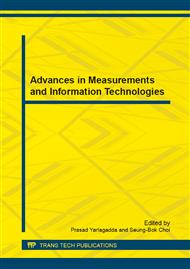[1]
Wan Y, Li L, He J, Anshan: Wireless sensor networks for equipment fault diagnosis in the process industry. Sensor, Mesh and Ad Hoc Communications and Networks, 2008: 314–322.
DOI: 10.1109/sahcn.2008.46
Google Scholar
[2]
Zuniga M, Krishnamachari B, An Analysis of Unreliability and Asymmetry in Low-Power Wireless Links. ACM Trans, Sensor Networks, 2007, 3(2): 7.
DOI: 10.1145/1240226.1240227
Google Scholar
[3]
Ergen, S, and Pravin V. TDMA scheduling algorithms for wireless sensor networks. Wireless Networks 16. 4 (2010): 985-997.
DOI: 10.1007/s11276-009-0183-0
Google Scholar
[4]
Lin X, Rasool S. Distributed and Provably Efficient Algorithms for Joint Channel-Assignment, Scheduling, and Routing in Multichannel Ad Hoc Wireless Networks, Networking, IEEE/ACM Transactions on, 2009, 17(6): 1874-1887.
DOI: 10.1109/tnet.2009.2021841
Google Scholar
[5]
Wan P, Yi C, Jia X, et al. Approximation algorithms for conflict-free channel assignment in wireless ad hoc networks. Wireless Communications and Mobile Computing, 2006, 6(2): 201–211.
DOI: 10.1002/wcm.380
Google Scholar
[6]
Madan R, Cui S, Lall S, et al. Cross-layer design for lifetime maximization in interference-limited wireless sensor networks. INFOCOM 2005, 24th Annual Joint Conference of the IEEE Computer and Communications Societies, Proceedings IEEE, 2005: 1964–(1975).
DOI: 10.1109/infcom.2005.1498474
Google Scholar
[7]
Lin X, Rasool S, A Distributed Joint Channel-Assignment, Scheduling and Routing Algorithm for Multi-Channel Ad-Hoc Wireless Networks. Proc, IEEE INFOCOM, (2007).
DOI: 10.1109/infcom.2007.134
Google Scholar
[8]
YANG, Yanhong, et al. Dynamic Time Division Multiple Access Algorithm for Industrial Wireless Hierarchical Sensor Networks., China Communications (2013): 137.
DOI: 10.1109/cc.2013.6520946
Google Scholar


